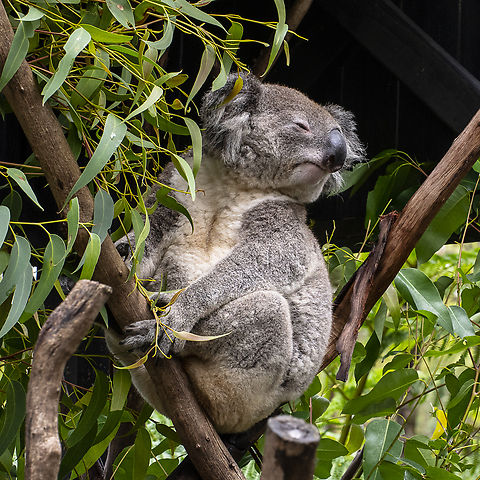
Appearance
The koala is a stocky animal with a large head and vestigial or non-existent tail. It has a body length of 60–85 cm and a weight of 4–15 kg, making it among the largest arboreal marsupials.Koalas from Victoria are twice as heavy as those from Queensland. The species is sexually dimorphic, with males 50% larger than females. Males are further distinguished from females by their more curved noses and the presence of chest glands, which are visible as hairless patches.
As in most marsupials, the male koala has a bifurcated penis, and the female has two lateral vaginas and two separate uteri. The male's penile sheath contains naturally occurring bacteria that play an important role in fertilisation. The female's pouch opening is tightened by a sphincter that keeps the young from falling out.
The pelage of the koala is thicker and longer on the back, and shorter on the belly. The ears have thick fur on both the inside and outside. The back fur colour varies from light grey to chocolate brown.
The belly fur is whitish; on the rump it is dappled whitish, and darker at the back. The koala has the most effective insulating back fur of any marsupial and is highly resilient to wind and rain, while the belly fur can reflect solar radiation.
The koala's curved, sharp claws are well adapted for climbing trees. The large forepaws have two opposable digits that allow them to grasp small branches. On the hindpaws, the second and third digits are fused, a typical condition for members of the Diprotodontia, and the attached claws are used for grooming.
As in humans and other primates, koalas have friction ridges on their paws. The animal has a sturdy skeleton and a short, muscular upper body with proportionately long upper limbs that contribute to its climbing and grasping abilities. Additional climbing strength is achieved with thigh muscles that attach to the shinbone lower than other animals. The koala has a cartilaginous pad at the end of the spine that may make it more comfortable when it perches in the fork of a tree.
The koala has one of the smallest brains in proportion to body weight of any mammal, being 60% smaller than that of a typical diprotodont, weighing only 19.2 g.
The brain's surface is fairly smooth, typical for a "primitive" animal. It occupies only 61% of the cranial cavity and is pressed against the inside surface by cerebrospinal fluid. The function of this relatively large amount of fluid is not known, although one possibility is that it acts as a shock absorber, cushioning the brain if the animal falls from a tree.
The koala's small brain size may be an adaptation to the energy restrictions imposed by its diet, which is insufficient to sustain a larger brain. Because of its small brain, the koala has a limited ability to perform complex, unfamiliar behaviours.
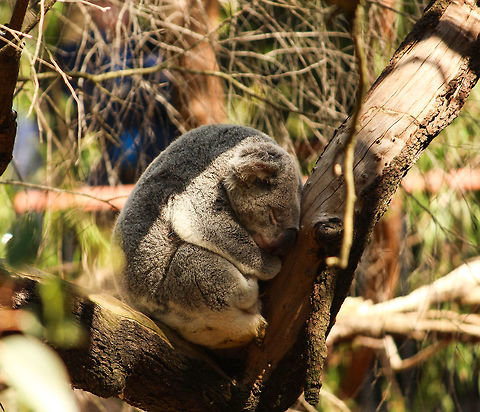
Naming
The word koala comes from the Dharug "gula". Although the vowel 'u' was originally written in the English orthography as "oo", it was changed to "oa", possibly in error.The word is mistakenly said to mean "doesn't drink". Because of the koala's resemblance to a bear, it was often miscalled the koala bear, particularly by early settlers.
Other names like monkey bear, native bear, and tree-bear have also been used. Indigenous names include "cullawine", "koolawong", "colah", "karbor", "colo", "coolbun", "boorabee", "burroor", "bangaroo", "pucawan", "banjorah", and "burrenbong"; many of these mean "no drink".
The generic name, "Phascolarctos", is derived from the Greek words "phaskolos" "pouch" and "arktos" "bear". The specific name, "cinereus", is Latin for "ash coloured".
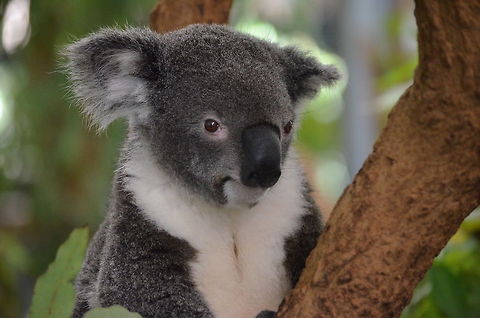
Distribution
The koala's geographic range covers roughly 1,000,000 km2, and 30 ecoregions.It extends throughout eastern and southeastern Australia, encompassing northeastern, central and southeastern Queensland, eastern New South Wales, Victoria, and southeastern South Australia. The koala was introduced near Adelaide and on several islands, including Kangaroo Island and French Island. The population on Magnetic Island represents the northern limit of its range.
In Queensland, koalas are unevenly distributed and uncommon except in the southeast, where they are numerous. In New South Wales, they are abundant only in Pilliga, while in Victoria they are common nearly everywhere. In South Australia, koalas were extirpated by 1920 and subsequently reintroduced.

Status
In 2008, the International Union for Conservation of Nature listed the koala under Least Concern for the following reasons: "Its wide distribution, presumed large population, and because it is unlikely to be declining at nearly the rate required to qualify for listing in a threatened category."Australian policy makers declined a 2009 proposal to include the koala in the Environment Protection and Biodiversity Conservation Act 1999. In 2012, the Australian government listed koala populations in Queensland and New South Wales as Vulnerable, because of a 40% population decline in the former and a 33% decline in the latter.
Populations in Victoria and South Australia appear to be abundant; however, the Australian Koala Foundation argues that the exclusion of Victorian populations from protective measures is based on a misconception that the total koala population is 200,000, whereas they believe it is probably less than 100,000.
Koalas were hunted for food by Aboriginals. A common technique used to capture the animals was to attach a loop of ropey bark to the end of a long, thin pole, so as to form a noose. This would be used to snare an animal high in a tree, beyond the reach of a climbing hunter; an animal brought down this way would then be killed with a stone hand axe or hunting stick. According to the customs of some tribes, it was considered taboo to skin the animal, while other tribes thought the animal's head had a special status, and saved them for burial.
The koala was heavily hunted by European settlers in the early 20th century, largely for its thick, soft fur. More than two million pelts are estimated to have left Australia by 1924.
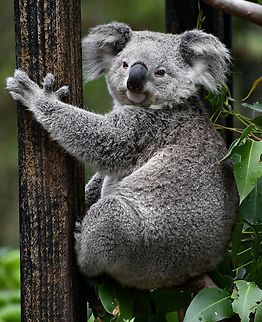
Behavior
Koalas are asocial animals and spend just 15 minutes a day on social behaviours.Koala society appears to consist of "residents" and "transients", the former being mostly adult females and the latter males. Resident males appear to be territorial and dominate others with their larger body size. Alpha males tend to establish their territories close to breeding females, while younger males are subordinate until they mature and reach full size.
Adult males occasionally venture outside their home ranges; when they do so, dominant ones retain their status. When a male enters a new tree, he marks it by rubbing his chest gland against the trunk or a branch; males have occasionally been observed to dribble urine on the trunk. This scent-marking behaviour probably serves as communication, and individuals are known to sniff the base of a tree before climbing.
Scent marking is common during aggressive encounters. Chest gland secretions are complex chemical mixtures—about 40 compounds were identified in one analysis—that vary in composition and concentration with the season and the age of the individual.
Adult males communicate with loud bellows—low pitched sounds that consist of snore-like inhalations and resonant exhalations that sound like growls. These sounds are thought to be generated by unique vocal organs found in koalas. Because of their low frequency, these bellows can travel far through air and vegetation.
Koalas may bellow at any time of the year, particularly during the breeding season, when it serves to attract females and possibly intimidate other males. They also bellow to advertise their presence to their neighbours when they enter a new tree. These sounds signal the male's actual body size, as well as exaggerate it; females pay more attention to bellows that originate from larger males.
Female koalas bellow, though more softly, in addition to making snarls, wails, and screams. These calls are produced when in distress and when making defensive threats. Young koalas squeak when in distress. As they get older, the squeak develops into a "squawk" produced both when in distress and to show aggression. When another individual climbs over it, a koala makes a low grunt with its mouth closed. Koalas make numerous facial expressions. When snarling, wailing, or squawking, the animal curls the upper lip and points its ears forward. During screams, the lips retract and the ears are drawn back. Females bring their lips forward and raise their ears when agitated.
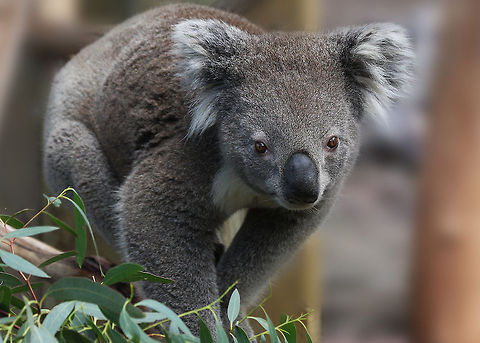
Habitat
Koalas can be found in habitats ranging from relatively open forests to woodlands, and in climates ranging from tropical to cool temperate. In semi-arid climates, they prefer riparian habitats, where nearby streams and creeks provide refuge during times of drought and extreme heat.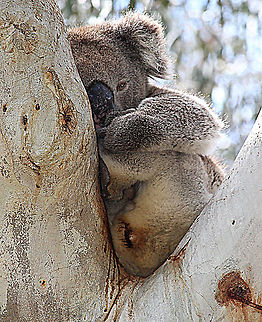
Reproduction
Koalas are seasonal breeders, and births take place from the middle of spring through the summer to early autumn, from October to May.Females in oestrus tend to hold their heads further back than usual and commonly display tremors and spasms. However, males do not appear to recognise these signs, and have been observed to mount non-oestrous females.
Because of his much larger size, a male can usually force himself on a female, mounting her from behind, and in extreme cases, the male may pull the female out of the tree. A female may scream and vigorously fight off her suitors, but will submit to one that is dominant or is more familiar.
The bellows and screams that accompany matings can attract other males to the scene, obliging the incumbent to delay mating and fight off the intruders. These fights may allow the female to assess which is dominant. Older males usually have accumulated scratches, scars, and cuts on the exposed parts of their noses and on their eyelids.
The koala's gestation period lasts 33–35 days, and a female gives birth to a single joey. As with all marsupials, the young are born while at the embryonic stage, weighing only 0.5 g. However, they have relatively well-developed lips, forelimbs, and shoulders, as well as functioning respiratory, digestive, and urinary systems. The joey crawls into its mother's pouch to continue the rest of its development. Unlike most other marsupials, the koala does not clean her pouch.
A female koala has two teats; the joey attaches itself to one of them and suckles for the rest of its pouch life. The koala has one of the lowest milk energy production rates in relation to body size of any mammal. The female makes up for this by lactating for as long as 12 months.
At seven weeks of age, the joey's head grows longer and becomes proportionally large, pigmentation begins to develop, and its sex can be determined. At 13 weeks, the joey weighs around 50 g and its head has doubled in size. The eyes begin to open and fine fur grows on the forehead, nape, shoulders, and arms. At 26 weeks, the fully furred animal resembles an adult, and begins to poke its head out of the pouch.
As the young koala approaches six months, the mother begins to prepare it for its eucalyptus diet by predigesting the leaves, producing a faecal pap that the joey eats from her cloacum. The pap is quite different in composition from regular faeces, resembling instead the contents of the caecum, which has a high concentration of bacteria.
Eaten for about a month, the pap provides a supplementary source of protein at a transition time from a milk to a leaf diet. The joey fully emerges from the pouch for the first time at six or seven months of age, when it weighs 300–500 g. It explores its new surroundings cautiously, clinging to its mother for support. By nine months, it weighs over 1 kg and develops its adult fur colour.
Having permanently left the pouch, it rides on its mother's back for transportation, learning to climb by grasping branches. Gradually, it spends more time away from its mother, and at 12 months it is fully weaned, weighing around 2.5 kg. When the mother becomes pregnant again, her bond with her previous offspring is permanently severed. Newly weaned young are encouraged to disperse by their mothers' aggressive behaviour towards them.
Females become sexually mature at about three years of age and can then become pregnant; in comparison, males reach sexual maturity when they are about four years old, although they can produce sperm as early as two years.
While the chest glands can be functional as early as 18 months of age, males do not begin scent-marking behaviours until they reach sexual maturity. Because the offspring have a long dependent period, female koalas usually breed in alternate years. Favourable environmental factors, such as a plentiful supply of high-quality food trees, allow them to reproduce every year.
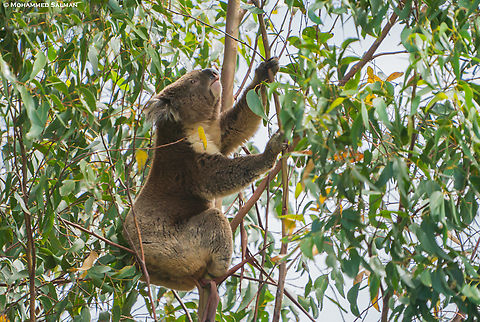
Predators
Koalas have few predators; dingos and large pythons may prey on them, while birds of prey are threats to young.They are generally not subject to external parasites, other than ticks in coastal areas. Koalas may also suffer mange from the mite "Sarcoptes scabiei", and skin ulcers from the bacterium "Mycobacterium ulcerans", but neither is common.
Internal parasites are few and largely harmless. These include the tapeworm "Bertiella obesa", commonly found in the intestine, and the nematodes "Marsupostrongylus longilarvatus" and "Durikainema phascolarcti", which are infrequently found in the lungs.
Koalas can be subject to pathogens such as Chlamydiaceae bacteria, which can cause keratoconjunctivitis, urinary tract infection, and reproductive tract infection. Such infections are widespread on the mainland, but absent in some island populations.
The koala retrovirus may cause koala immune deficiency syndrome which is similar to AIDS in humans. Prevalence of KoRV in koala populations suggests a trend spreading from the north to the south of Australia. Northern populations are completely infected, while some southern populations are free.
The animals are vulnerable to bushfires due to their slow movements and the flammability of eucalypt trees. The koala instinctively seeks refuge in the higher branches, where it is vulnerable to intense heat and flames. Bushfires also fragment the animal's habitat, which restricts their movement and leads to population decline and loss of genetic diversity.
Dehydration and overheating can also prove fatal. Consequently, the koala is vulnerable to the effects of climate change. Models of climate change in Australia predict warmer and drier climates, suggesting that the koala's range will shrink in the east and south to more mesic habitats.
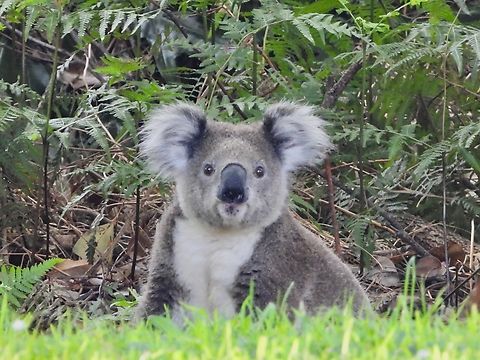
Evolution
The modern koala is the only extant member of Phascolarctidae, a family that once included several genera and species. During the Oligocene and Miocene, koalas lived in rainforests and had less specialised diets. Some species, such as the Riversleigh rainforest koala and some species of "Perikoala", were around the same size as the modern koala, while others, such as species of "Litokoala", were one-half to two-thirds its size. Like the modern species, prehistoric koalas had well developed ear structures which suggests that long-distance vocalising and sedentism developed early.During the Miocene, the Australian continent began drying out, leading to the decline of rainforests and the spread of open "Eucalyptus" woodlands. The genus "Phascolarctos" split from "Litokoala" in the late Miocene and had several adaptations that allowed it to live on a specialised eucalyptus diet: a shifting of the palate towards the front of the skull; larger molars and premolars; smaller pterygoid fossa; and a larger gap between the molar and the incisor teeth.
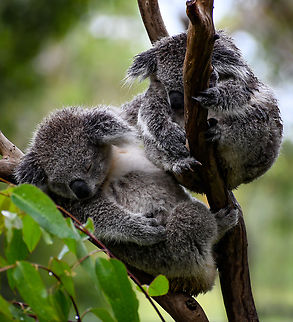
Cultural
The koala is well known worldwide and is a major draw for Australian zoos and wildlife parks.References:
Some text fragments are auto parsed from Wikipedia.